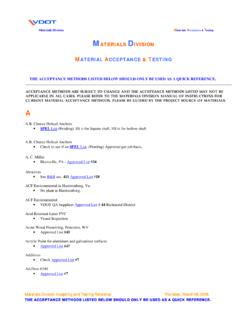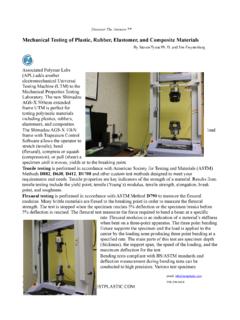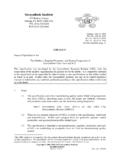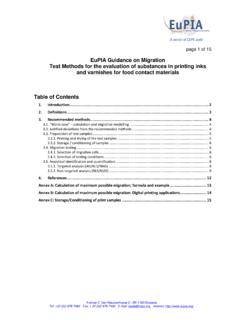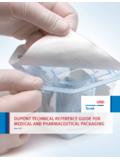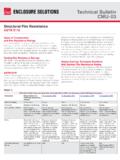Transcription of The Advantages & Challenges of Phase Change …
1 The Advantages & Challenges of Phase Change Materials (PCMs) In Thermal Packaging Author Richard M. Formato, R&D Manager Cold Chain Technologies 2 OVERVIEW Cold Chain Technologies, Inc. (CCT) designs and manufactures temperature controlled packaging that employs Phase Change Materials (PCMs). PCMs are passive thermal energy storage materials used in the thermal packaging industry to maintain a temperature sensitive product within the manufacturer s required temperature range during all transportation phases ( from manufacture to end user). Typical temperature requirements for temperature sensitive products range from 80 C to +40 C, the most common being at a point between 2 C and 8 C. PCMs are commonly used in combination with water based refrigerants (or by themselves) within insulated shipping containers. To increase the duration of thermal control within a given temperature range, PCMs are normally selected such that their Phase Change temperature is within the required temperature range of the product being shipped ( +5 C PCM is used to meet a +2 C to +8 C temperature requirement).
2 As the PCM changes its Phase (for example, from solid to liquid, at 5 C) it effectively extends the duration of temperature control by cooling the product via its latent heat. Although liquid water will resist temperature Change , it does not undergo a Phase Change until 0 C. As such, for a 2 C to 8 C shipper, using liquid water (only) to protect the product from getting to hot or too cold is much less efficient than using a PCM. Some quick calculations quantify this: WATER: Energy removal to lower [1kg] of liquid water from (+5 C) to (+2 C) = kJ +5 C PCM: Energy removal to lower [1kg] of liquid PCM (+5 C) to frozen PCM (+2 C) = kJ In the above scenario, almost nineteen times ( kJ kJ) more energy is needed to Change the temperature of the PCM compared to liquid water! The result is that considerably less (weight) of PCM is required to protect the product from low temperature exposure as compared to water.
3 Efficient use of PCMs will result in smaller, lighter (reduced freight) thermal packaging designs that outperform their water based counterparts. This benefit can be used for both summer and winter cycles (melting or freezing of PCM) as long as the PCM Phase Change temperature is within the desired product temperature range. Figure 1, below, illustrates the increased performance that can be achieved by using PCM in place of water based refrigerants: The figure shows a graph of product temperature versus time of a PCM based solution (right) vs. a water based solution (left). As shown, the product temperature at the end of the profile (test) is approximately 2 C lower for the PCM based solution which results in increased duration of temperature control. It is also important to note the minimum product temperatures in the water based solution compared to the PCM based solution.
4 The water based solution product temperature is very close to the +2 C lower temperature limit, while the +5 C PCM based solution maintains the product temperature within +/ 1 C of +5 C after the initial stabilization period (first few hours) in the shipping solution. As such, relatively small changes to the ambient temperature profile could result in a lower temperature limit failure in the water based design whereas the PCM based solution is much more robust. 3 Figure 1: Comparison of a typical Water based design vs. PCM based design Water based Solution +5 C PCM based Solution PCMs are specialty, not commodity, materials and as a result are much more costly than their water based counterparts. However, in many cases the added cost of the PCM is more than offset by reduction in freight, resulting in lower total system costs (packaging plus freight).
5 Table 1, below, compares several PCM designs developed to replace existing qualified water based designs for refrigerated (+2 C to +8 C) product shipments. Table 1: Comparison of [2 to 8 C] PCM designs vs. Water Based designs Water Based PCM Based Water Based PCM Based Water BasedPCM BasedInsulation TypePolyurethaneExpanded Polystyrene (EPS)PolyurethaneVacuum Insulation Panel (VIP)Qualified Duration at 2 8 C48 hours72 hours48 Hours48 Hours48 Hours72 HoursWeight of Solution (no product)24 lbs36 lbs36 lbs23 lbsDimensional Weight (Factor of 166)30 lbs27 lbs48 lbs27 lbs48 lbs15 lbsSystem Cost$70$65$85$30$105$135 Estimated Freight Costs ($ / lb)$36$32$58$35$58$28 Total Cost of Ownership$106$97$143$65$163$163 Example 1 Example 2 Example 3 Comparison CharacteristicPolyurethane 4 Types of PCMs Typically Used in Thermal Packaging PCMs typically used in thermal packaging are usually grouped by their chemical makeup ( organic or inorganic ), with the most common being organic.
6 Organic PCMs, which are oil based, have the (CH2)n group that provides their high latent heat. A number of types of organic PCMs are currently used by packaging providers including: n alkanes, fatty acid methyl esters ( methyl esters ), fatty acids and fatty alcohols. The inorganic PCMs are aqueous (water based) salt hydrates ( Salt nH2O). There are a number of key attributes for a PCM that should be considered. Overall, the attributes of a perfect PCM are: Phase Change temperature in desired range with sharp melting/freezing point High latent heat of fusion (solid to liquid) Non toxic (to humans/animals) & non carcinogenic Commercially available at low cost Does not react with and/or act as a solvent for packaging materials Landfill disposable and/or waterway disposable Biodegradable Low/non flammable (high flash point, low vapor pressure) Non corrosive Good stability upon thermal cycling (no super cooling) Limited volumetric expansion/contraction upon freeze/thaw Table 2, below, summarizes, by generic type, PCMs that have been used in Cold Chain applications, along with the (Pros) and (Cons) of each.
7 Table 2: Organic/Inorganic PCMs used in Cold Chain Applications Generic Name: Formula Pros (Cold Chain Applications)Cons (Cold Chain Applications) n Alkanes: CH3(CH2)nCH3 High latent heat; inert, non toxic, non corrosive Limited availability, limited biodegradability Fatty Acid Methyl Esters: CH3(CH2)nCOOCH3 Biodegradable, non toxic, non corrosive Limited availability, strong odor, solvent for EPS, latent heat below alkanes Fatty Alcohols: CH3(CH2)nCH2OH Biodegradable, non toxicLimited availability, odor, flammable, easily oxidized, latent heat below alkanes Fatty Acids: CH3(CH2)nCOOH Biodegradable, good cycling stability, limited super cooling Limited availability, causes burns, corrosive, latent heat below alkanes Salt Hydrates (inorganic): Salt nH2O Water based systems, packaging compatible, good latent heat Very limited availability, poor cycling stability, may be corrosive 5 Challenges Associated with PCMsWhile there can be a significant advantage to using PCMs in certain thermal packaging applications (as outlined above), there are also a number of Challenges regarding their manufacture and use that need to be understood and addressed by both the PCM manufacturer and the end user.
8 The key Challenges include: material Compatibility material Properties and Thermal Performance Packaging for Use Conditioning for Use Cost and Availability Health & Safety and Disposal The following sections cover these specific Challenges in greater detail and explain Cold Chain Technologies approach to address each including the PCM selection process, ongoing research & development efforts, and manufacturing improvements. material Compatibility Since PCMs are oil based their compatibility with packaging materials must be evaluated. This evaluation must include both the materials used to encase the PCM ( films) and other packaging materials used in the thermal shipping solutions ( insulation and corrugate). The most important factors to be considered are permeability and solubility of the PCM with the packaging materials. If the PCM and the material used to encase it are not compatible, the PCM can permeate through the packaging material relatively quickly after it is manufactured.
9 Considering solubility, in the event of a leak (puncture) caused by the physical stresses of distribution (vibration, drop and/or pressure) the leaking PCM material could act as a solvent for, or in the worst case dissolve, the other packaging materials. An example of this is shown below (Figure 3a) when a commercially available used organic, fatty acid methyl ester PCM (about 100 ml or oz) is placed in direct contact with an Expanded Polystyrene (EPS) shipper. The hole shown through the EPS shipper wall occurred after only 10 minutes of exposure. Figure 3b shows the same shipper after an overnight exposure. Figure 3a: Fatty Acid Methyl Ester PCM on EPS Shipper 10 minutesFigure 3b: Fatty Acid Methyl Ester PCM on EPS Shipper Overnight 6 Cold Chain Technologies has performed extensive permeability and solubility testing with the various types of PCMs to evaluate them with commonly used packaging materials for flexible gel pack refrigerants.
10 Table 4 below summarizes this testing. Additionally, solubility testing was completed on typical shipper components and materials including: Expanded Polystyrene (EPS), Polyurethane Foam (PUR), Vacuum Insulation Panels (VIPs) and corrugate. Table 4: Summary of Permeability Testing with alkane PCM material Properties and Thermal Performance As mentioned previously there are a number of key material attributes that should be characterized for any PCM including the Phase Change temperature, existence of a sharp melting/freezing point, latent heat of fusion, toxicity, flash point, vapor pressure, corrosiveness, material purity, odor and thermal stability upon thermal cycling. Among the commonly used PCMs in thermal packaging today, the following negative attributes were studied and used in the selection process for Cold Chain Technologies PCM: Fatty alcohols were eliminated due to their pungent odor and flammability.
